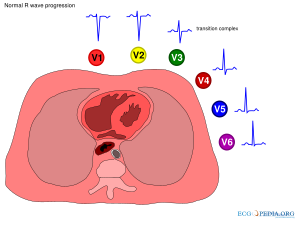

8 The ARIC study was approved by the institutional review board at each site. Subsequent contact included annual phone interviews, 3 short‐term repeat examinations spaced ≈3 years apart (1990–1992, 1993–1995, and 1996–1998), and the latest visit, which was completed between 20. Between 19, 15 792 adults aged 45 to 64 years were enrolled from 4 US communities-northwest suburbs of Minneapolis, MN Washington County, MD Jackson, MS Forsyth County, NC-and underwent a comprehensive baseline assessment. The ARIC study is a community‐based prospective cohort with a main focus on the cause and natural history of atherosclerosis and its clinical manifestations and community burden. In addition, we explored baseline factors associated with subsequent changes in QRS transition zone over 9 years.

Thus, we aimed to investigate the association of clockwise and counterclockwise rotation of QRS transition zone over 9 years, as a time‐varying exposure, with subsequent risk of CVD during a median follow‐up of 23 years in whites and blacks from the ARIC (Atherosclerosis Risk in Communities) study. Also, those 3 previous studies looked at rotation at baseline only, and, therefore, it is unclear to what extent the rotation changes within an individual over time, what factors correlated with those changes, and whether time‐varying data on rotation has prognostic information. In this context, it is of note that the Finnish study did not observe significant associations of QRS transition zone with hospitalizations caused by coronary heart disease (CHD) and heart failure (HF), 7 warranting further investigations. 7 Mortality is an important outcome but, from an etiological perspective, it is important to investigate individual CVD outcomes including nonfatal cases. 5 Similar patterns for mortality were confirmed in 2 recent studies from the United States (based on the third NHANES ) 6 and Finland (based on the Finnish Social Insurance Institution's Coronary Heart Study). A study from Japan was the first to report that clockwise and counterclockwise rotation of QRS transition zone in 12‐lead ECGs were associated with significantly higher and lower risk of mortality caused by composite cardiovascular disease (CVD) and all causes, respectively, as compared with no rotation.

1, 2, 3, 4 In this context, clockwise and counterclockwise rotations of QRS transition zone in horizontal plane are long‐recognized ECG findings, but their prognostic value is not fully understood. In addition, several ECG parameters (eg, bundle branch block, frontal QRS‐T angle, QT interval, left ventricular hypertrophy) predict future cardiovascular events. However, QRS transitional zone information is automatically obtained when ECG is assessed, and, thus, in such a case, clinical attention should be paid to persons with clockwise rotation, particularly for the risk of heart failure.ĮCG has been useful for diagnosing several heart conditions including cardiac arrhythmia, cardiac ischemia, and structural changes such as left ventricular hypertrophy. Overall modest associations may question the prognostic value of QRS transitional zone. Our results support a proposal from some experts to rethink the definition of “normal” QRS transitional zone. On the contrary, counterclockwise rotation was significantly related to lower risk of composite CVD (hazard ratio, 0.93 95% CI, 0.87–0.99]), CVD mortality (hazard ratio, 0.76 95% CI, 0.65–0.88), and non‐ CVD deaths (hazard ratio, 0.92 95% CI, 0.85–0.99 ). Clockwise rotation was significantly associated with higher risk of heart failure (hazard ratio, 1.20 95% confidence interval, 1.02–1.41) and non‐ CVD death (hazard ratio, 1.28 95% CI, 1.12–1.46) after adjusting for potential confounders including other ECG parameters. Of patients with no rotation, 57.9% experienced counterclockwise or clockwise rotation during follow‐up, with diabetes mellitus and black race significantly predicting clockwise and counterclockwise conversion, respectively. At baseline, counterclockwise rotation was most prevalent (52.9%), followed by no (40.5%) and clockwise (6.6%) rotation.


 0 kommentar(er)
0 kommentar(er)
